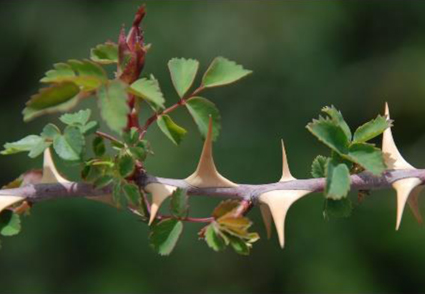Abstract
In this paper, a new species of the genus Rosa from China, Rosa tomurensis L. Luo, C. Yu & Q. X. Zhang, is described and illustrated. In the past, R. tomurensis was considered as a variety of Rosa laxa. After years of field investigation, introduction and cultivation, comparison and measurement of plant specimens, our research team found that R. tomurensis has stable characters, and its morphological characteristics, sporopollen, chromosome karyotype and genome are obviously different from R. laxa. Therefore, it is confirmed that R. tomurensis is an independent species in Rosa.
References
IUCN Standards and Petitions committee (2022) Guidelines for Using the IUCN Red List Categories and Criteria. Version 15. Prepared by the Standards and Petitions Committee. Available from: https://nc.iucnredlist.org/redlist/content/attachment_files/RedListGuidelines.pdf (accessed 15 March 2022)
Ku, T.C. & Robertson, K.R. (2003) Rosa (Rosaceae). In: Wu, Z.Y. & Raven, P.H. (Eds.) Flora of China, vol. 9. Science Press, Beijing & Missouri Botanical Garden Press, St. Louis, pp. 339–381.
Liu, S.X. (1993) Rosa in Xinjiang. Plants 6: 19–21. [In Chinese]
Liu, S.X. & Cong, Z.F. (2000) Rosa in Xinjiang. Xinjiang Science and Technology Health Publishing House, Xinjiang, pp. 3–47. [In Chinese]
Luo, L., Yu, C., Guo, X.L., Pan, H.T. & Zhang, Q.X. (2018) Morphological Variation and Palynomorphology of Rosa laxa in Xinjiang, China. Journal of the American Society for Horticultural Science 143 (6): 409–417. https://doi.org/10.21273/jashs04422-18
Luo, L., Zhang, Q.X., Yu, C. & Pan, H.T. (2017) Pollen Morphology Analysis of 29 Rosa Germplasm. Acta Botanica Boreali-Occidentalia Sinica 37 (5): 885–894. [in Chinese]
Ma, Y. & Chen, J.Y. (1990) Germplasm resources of Rosa in northeast of China. Chinese Landscape Architecture 1: 50–51. [In Chinese]
Ma, Y. & Chen, J.Y. (1991) Chromosome studies of seven roses. Journal of Fujian College of Forestry 11 (2): 215–218. [In Chinese]
Mao, Z.M., Liu, J.G., Pi, X.M., An, X.Z., Zhou, G.L., Yang, C.Y., Han, Y.L., Li, X.Y. & Zhang, Y.F. (1995) Flora Xinjianggensis Vol. 2. Xinjiang Science and Technology Health Publishing House, Xinjiang, pp. 342–343. [In Chinese]
Porebski, S., Bailey, L.G. & Baum, B.R. (1997) Modification of a CTAB DNA extraction protocol for plants containing high polysaccharide and polyphenol components. Plant Molecular Biology Reporter 15 (1): 8–15. https://doi.org/10.1007/BF02772108
Quest-Ritson, C. & Quest-Ritson, B. (2003) The American Rose Society encyclopedia of roses. DK Publishing, New York, pp. 1–22.
Rehder, A. (1940) Manual of cultivated trees and shrubs. MacMillan, London, pp. 996–998.
Turland, N.J., Wiersema, J.H., Barrie, F.R., Greuter, W., Hawksworth, D.L., Herendeen, P.S., Knapp, S., Kusber, W.H., Li, D.Z., Marhold, K., May, T.W., McNeill, J., Monro, A.M., Prado, J., Price, M.J. & Smith, G.F. (2018) International Code of Nomenclature for algae, fungi, and plants (Shenzhen Code) adopted by the Nineteenth International Botanical Congress Shenzhen, China, July 2017. Regnum Vegetabile 159. Koeltz Botanical Books, Glashütten, pp. 1–254. https://doi.org/10.12705/Code.2018
Yu, C., Luo, L., Wang, Y.H., Liu, J., Pan, H.T. & Zhang, Q.X. (2011) Discussion and analysis of the karyotype of Rosa laxa in Xinjiang. Acta Botanica Boreali-Occidentalia Sinica 31 (12): 2459–2463. [In Chinese]
Yu, C., Luo, L., Pan, H.T., Sui, Y.J., Guo, R.H., Wang, J.Y. & Zhang, Q.X. (2014) Karyotype Analysis of Wild Rosa Species in Xinjiang, Northwestern China. Journal of the American Society for Horticultural Science 139 (1): 39–47. https://doi.org/10.21273/jashs.139.1.39
Yu, T.T., Ku, T.C., Li, C.L. & Lu L.T. (1985) Flora Republicae Popularis Sinicae. Vol. 37. Science Press, Beijing, pp. 360–371. [In Chinese]
Ku, T.C. & Robertson, K.R. (2003) Rosa (Rosaceae). In: Wu, Z.Y. & Raven, P.H. (Eds.) Flora of China, vol. 9. Science Press, Beijing & Missouri Botanical Garden Press, St. Louis, pp. 339–381.
Liu, S.X. (1993) Rosa in Xinjiang. Plants 6: 19–21. [In Chinese]
Liu, S.X. & Cong, Z.F. (2000) Rosa in Xinjiang. Xinjiang Science and Technology Health Publishing House, Xinjiang, pp. 3–47. [In Chinese]
Luo, L., Yu, C., Guo, X.L., Pan, H.T. & Zhang, Q.X. (2018) Morphological Variation and Palynomorphology of Rosa laxa in Xinjiang, China. Journal of the American Society for Horticultural Science 143 (6): 409–417. https://doi.org/10.21273/jashs04422-18
Luo, L., Zhang, Q.X., Yu, C. & Pan, H.T. (2017) Pollen Morphology Analysis of 29 Rosa Germplasm. Acta Botanica Boreali-Occidentalia Sinica 37 (5): 885–894. [in Chinese]
Ma, Y. & Chen, J.Y. (1990) Germplasm resources of Rosa in northeast of China. Chinese Landscape Architecture 1: 50–51. [In Chinese]
Ma, Y. & Chen, J.Y. (1991) Chromosome studies of seven roses. Journal of Fujian College of Forestry 11 (2): 215–218. [In Chinese]
Mao, Z.M., Liu, J.G., Pi, X.M., An, X.Z., Zhou, G.L., Yang, C.Y., Han, Y.L., Li, X.Y. & Zhang, Y.F. (1995) Flora Xinjianggensis Vol. 2. Xinjiang Science and Technology Health Publishing House, Xinjiang, pp. 342–343. [In Chinese]
Porebski, S., Bailey, L.G. & Baum, B.R. (1997) Modification of a CTAB DNA extraction protocol for plants containing high polysaccharide and polyphenol components. Plant Molecular Biology Reporter 15 (1): 8–15. https://doi.org/10.1007/BF02772108
Quest-Ritson, C. & Quest-Ritson, B. (2003) The American Rose Society encyclopedia of roses. DK Publishing, New York, pp. 1–22.
Rehder, A. (1940) Manual of cultivated trees and shrubs. MacMillan, London, pp. 996–998.
Turland, N.J., Wiersema, J.H., Barrie, F.R., Greuter, W., Hawksworth, D.L., Herendeen, P.S., Knapp, S., Kusber, W.H., Li, D.Z., Marhold, K., May, T.W., McNeill, J., Monro, A.M., Prado, J., Price, M.J. & Smith, G.F. (2018) International Code of Nomenclature for algae, fungi, and plants (Shenzhen Code) adopted by the Nineteenth International Botanical Congress Shenzhen, China, July 2017. Regnum Vegetabile 159. Koeltz Botanical Books, Glashütten, pp. 1–254. https://doi.org/10.12705/Code.2018
Yu, C., Luo, L., Wang, Y.H., Liu, J., Pan, H.T. & Zhang, Q.X. (2011) Discussion and analysis of the karyotype of Rosa laxa in Xinjiang. Acta Botanica Boreali-Occidentalia Sinica 31 (12): 2459–2463. [In Chinese]
Yu, C., Luo, L., Pan, H.T., Sui, Y.J., Guo, R.H., Wang, J.Y. & Zhang, Q.X. (2014) Karyotype Analysis of Wild Rosa Species in Xinjiang, Northwestern China. Journal of the American Society for Horticultural Science 139 (1): 39–47. https://doi.org/10.21273/jashs.139.1.39
Yu, T.T., Ku, T.C., Li, C.L. & Lu L.T. (1985) Flora Republicae Popularis Sinicae. Vol. 37. Science Press, Beijing, pp. 360–371. [In Chinese]


